Managing Director:
Mrs. Edith GASANA
E-mail: e.gasana@brd.com.rw
; dgbrd@rwanda1.com
Director of Finance Project Department:
Mr. Jean Pierre RUBULIKA
E-mail: jp.rubulika@brd.com.rw
Secretary General:
Mr. Timothée KARERA
E-mail: t.karera@brd.com.rw
"Thirty five years experience in investment
promotion and finance of projects for the socio-economic
development of Rwanda".
 CREATION
AND MISSION CREATION
AND MISSION |
The BRD was created in 1967 by special law.
Its mission as a long term lender, is to operate
in all sectors of productive investment, which generates
added value and creates employment.
 MAJOR SHAREHOLDERS MAJOR SHAREHOLDERS
-Government of Rwanda: 48.12%
-Belgian cooperation: 8.53%
-AFD: 9.14%
-FMO: 6.47%
-DEG: 9.01%
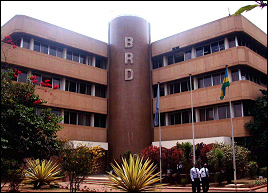
 MAIN
PARTNERS MAIN
PARTNERS |
- A.D.B Group (African Development Bank)
- KFW (KREDITANSTALT FUR WIEDERAUFBAU)
- A.F.D (French Development Agency)
- World Bank / I.D.A Group
- DEG (German Investment Finance Company)
- FOM (Netherlands Finance Company)
- B.C (Belgian Co-operation)
- E.I.B. (European Investment Bank)
 MANAGEMENT
ORGANS MANAGEMENT
ORGANS |
- A General Assembly of Shareholders
- A Board of Directors
- A Finance Committee
- A Management Director
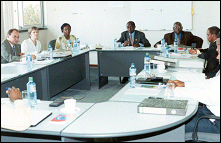
 OBJECTIVES
OF THE BANK OBJECTIVES
OF THE BANK |
The Bank is aimed at financial contribution toward
the economic development of Rwanda. In this respect,
the Bank can carry out the following operations
on its own behalf, on behalf of the governement
and public institutions as well as that of companies
and individuals in the private sectror :
1. To take active interest in the creation and development
of enterprises that can contribute to the economic
development of the country, by way of direct or
indirect contribution to the capital, subscription
of bonds, cash vouchers or equivalents, and granting
of short, medium and long term credit ;
2. To provide technical support in the assessment
and study of problems and projects of interest to
the country ;
3. To search for and study investment opportunities
useful to the development of the national economy
;
4. To promote key enterprises that arise from national
development plans ;
5. To render technical assistance to existing enterprises
and those being formed, with regard to searching
for solutions to all sorts of problems relating
to their organisation, operation, and management
;
6. To mobilise both internal and external resources
for investment and financing of all banking operations
;
7. To receive and manage all types of funds, whether
special or not, public or private ;
8. To make all the other operations that directly
or indirectly facilitate the fulfilment of its purpose.
 THE
BANK'S RESOURCES THE
BANK'S RESOURCES |
The BRD mobilises resources in several ways :
- It contacts credits from International Financial
Institutions and Development Agencies ;
- It mobilises local resources from financial institutions
within the country, especially the Bank of Rwanda
; and
- It uses its own funds as well as special funds
put at its disposal by the Goverment or its partners.
SECTORS OF OPERATION
The Rwanda Development Bank operates in all sectors
of productive investment which generate added value
and create employment.
In its credit policy, priority is given to the new
technologies and export oriented project. The Bank's
field of intervention covers the following areas
:
- Agriculture and Livestock
- Industry and agro-industry
- Crafts : mechanised carpentry, garages, confectionneries
and bakeries
- Mining
- Services such as hotels, petrol stations, private
scholls, pharmacies and clinics, socio-cultural
centers, equipment and infrastructure for commercial
production, professionnal facilities (machines,
computers), trasnport and communications, etc...
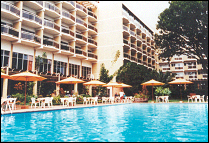
LENDING CONDITIONS
General Conditions
The main conditions for obtaining the Bank's financial
backing are follows :
1. A feasibility study for the project ;
2. Adequate technical capacity in the field of the
project for which finance is being sougth ;
3. Capacity to manage the project ;
4. Adequate market share to ensure a good turnover
level, and project profitability ;
5. A minimum participation by the promoter varying
between 30 and 50% of the cost of investment according
to the size of the project . For expansion projects,
the contribution of the Bank can represent the totality
of the necessary investment.
Loans Securities
The Bank must get adequate guarantees for the loans
it gives out. These are usually in the form of :
- Mortgages with title deeds,
- A pledge of receivables ,
- The joint guaranty of associates or partners etc
;
- A guaranty from the Government, a guarantee fund,
a bank, other partners, foreign organisations, etc
;
- The pledge of material or financial resources,
tangible assets ;
- Accident and fire insurance, etc
Financial Conditions
Interest rate
The interest rate is negociable between the Bank
and the customer and takes into account of the cost
of resources used for the financing , the collateral
security offered, the risk of the investment, the
credibility of the promoter and the economic and
the social impact of the project. The rate curently
varies from 12 to 16%.
Repayment period
The repayment period varies and can be up to 10
years depending on the cash -flow projected for
the project. At present, the average repayment period
is between 7 and 8 years, which makes the B.R.D.
the only financial institution in the country specialised
in long term financing.
 PERFORMANCE
TO DATE PERFORMANCE
TO DATE |
-Supported investments: 42 Billion Rwf
-Created added value: 43 Billion Rwf
-Creation of emplyment: 26,416 jobs
BRD participated in 33 enterprises for 559 million
Rwf.
Examples: Magerwa, Tabarwanda, Sowarthe, Hotel des
Milles Collines, Rwandatel, Sorwal, Sulfo Rwanda,
Highland Flowers, etc.
Leader in productive and long term investment. (over
80% of all private productive investment from 1967
to date were financed by BRD). The bank has played
a important role in major companies and projects
such as tea factories (Funda, Nyabihu, …) coffee
factories, BRALIRWA, Irish potatoes developments,
dairies farms, fresh vegetables, fruits (passion
fruits, pineapple), import substitution Factories,
etc.
Performance after 1994
Major in rehabilitation of industrial and tourism
sectors after 1994
Leader in long term financing in the rural sector
with important contribution to poverty reduction
and job creation since 2000.
Examples:
Pyrethrum: 18,000 households (realized)
Coffee: 3,000 households (realized)
Rice: 1,200 households (realized)
Fishing: 1,000 households (realized)
Flowers: 120 jobs realized
Diary farming: 2,400 jobs (50% realized, 50% in
development)
Tomato: 2,000 households (in development)
Maize: 2,000 households (in development)
Sugar: 3,300 jobs of which 75% are women (in development)

TOTAL: 33,020 households
Loan Portfolio 1994 to 2001
|
94 |
95 |
96 |
97 |
98 |
99 |
00 |
01 |
30/04/02 |
| Billion Rwf |
3.2 |
3.2 |
3 |
3.5 |
4.5 |
6.1 |
6.4 |
6 |
6.6 |
Balance sheet 1994 to 2001
|
94 |
95 |
96 |
97 |
98 |
99 |
00 |
01 |
| Total assets (in billion
Rwf) |
4 |
4.2 |
4.7 |
5.9 |
6.6 |
7.3 |
7.4 |
7.7 |
Note:
-Between 1994 and 2001, total assets have almost
doubled to due to growth in the loan portfolio.
-The financial structure of the balance sheet
is sound, thanks to its strong capital base and
very prudent provision policy.
Key ratios
Key
ratios table
Comments
-The bank registers a strong treasury capable
to shoulder its debt without any difficulty (5
times compared to standard of 1.0).
-The bank's equity capital structure is exceptionally
strong and enables the bank to venture into external
loan refinancing and raise its current loan portfolio
up to 7 times.
-The profitability of the bank has declined since
1998, one of the reasons being the high costs
of financial resources. To alleviate this situation,
the management pursuing the strategy to increase
the bank's performing portfolio with particular
emphasis on new products.
 HISTORY HISTORY |
The Banque Rwandaise de Développement (B.R.D),
is a Public limited liability company created by
the Law of August 5, 1967. For the last three decades,
BRD has been the sole provider of long term finance
and has significantly facilitated the emergence
of different productive enterprises in the private
sector. The Bank 's operational history is subdivided
in four phases.
1°) Establishment and development phase (1968
to 1987).
¨ During the years 1968 to 1970, the Bank was
being established and no projects were financed.
¨ In the four years that followed, the Bank
recorded meager loans on vehicles (pick-ups) and
grinding mills. The financing of the vehicles extended
all over the country and marked a crucial step towards
improving accessibility of goods in the country.
¨ Effective from 1974, the bank embarked on
aggressive financing of different sectors of the
economy.
An amount of loans totaling FRW 6,6 billions has
since been extended to 501 operations.
- FRW 317 millions invested in equity shares with
23 companies
- FRW 6,3 billions in loans to 478 borrowers .
This meant an investment impact of about FRW 12,6
billions with a creation of employment opportunities
for 8.400 people and cumulative added value of FRW
25,2 billions.
The bank has financed about 80 % of the country
's medium and long term loan portfolio in the productive
ventures.
PHASE 1: 1968-1987
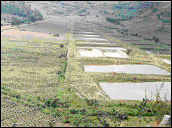
Pisciculture, Butare (1987)
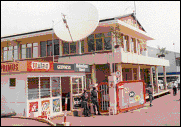
Bralirwa (1975)
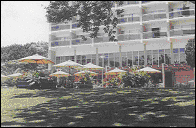
Milles Collines Hotel (1986)
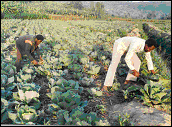
Crop culture, Kibungo (1987)
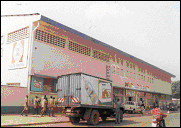
SULFO (1975)
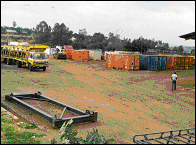
MAGERWA (1986)
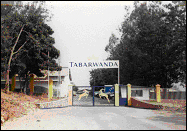
TABARWANDA (1975)
2°)Maturity phase (1988 - 1994)
During this period, the Bank disbursed loans totaling
- FRW 4,6 billions in 873 lines of credit
- FRW 84,5 millions in equity shares in 7 productive
ventures.
It generated an investment volume of FRW 15,7 billions
with a creation of employment for 9.094 people and
value added to the economy of FRW 8,5 billions.
The priority areas for the loans were agro-industries
mainly the sectors of tea and manufacturing, enabled
by low cost financial resources available to small
and medium scale enterprises in agribusiness; artisans
and micro- projects
PHASE II: 1988-1994
Primary Sector

Pineapple Culture, Kibungo (1988)

Tomato Culture, Mugambazi (1988)
Secondary Sector

RULIBA (1991)

Sugar factory, Kabuye (1994)
Tertiary Sector

Isimbi Hotel (1989)

AMEKI MEUBLES (1989)
3°) Post-Genocide phase (1995-2000).
The events of the 1994 genocide led to catastrophic
results that followed. The bank continues to shoulder
a burden of more than 50 % of its portfolio constituting
non- performing loans consequential from the 1994
genocide. An amount of loans totaling FRW 6, 8 billions,
115 operations
- FRW 6,7 billions in 112 lines of credit
- FRW 156, 4 millions in equity shares in 3 productive
ventures
The loans were mainly invested in modernization
and rehabilitation of ventures to the tune of FRW
13,4 billions, creating an employment of 8.923 people
and an added value to the economy of about FRW 8
billions. The war paralyzed the rural areas and
revitalization of the activities after 1994 concentrated
in the capital city mainly in the secondary and
tertiary sectors.
PHASE III: 1995-2000

Animal Husbandry

High Land Flowers

RWANDAFOAM

OPYRWA

Dairy factory, Rubilizi

Novotel Kigali

La Colombière

TOTAL Petrol Station
4°) Redeployment of activities and innovation
phase (2002-2005)
The Bank aims to double its portfolio, from 5,000
million RWF in 2001 to 10,000 million RWF in 2005.
Its interventions in financing will be diversified.
The rural projects and agro-businesses will be given
a privileged place in order to take part in the
revitalisation of the rural economy. New instruments
of financing like the microfinance and the leasing
will be introduced.
4°) Redeployment of activities and innovation
phase (2002-2005)
The Bank aims to double its portfolio, from 5,000
million RWF in 2001 to 10,000 million RWF in 2005.
Its interventions in financing will be diversified.
The rural projects and agro-businesses will be given
a privileged place in order to take part in the
revitalisation of the rural economy. New instruments
of financing like the microfinance and the leasing
will be introduced.
PHASE IV: 2001-2005
Primary Sector
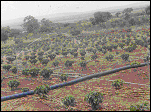
Coffee Plantation (2001)
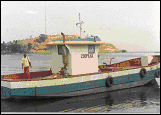
Fishing, Coopilack (2001)
Secondary Sector
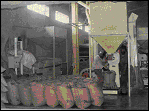
Agrocofee (2001-2005)
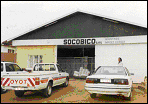
Socobico
Tertiary Sector
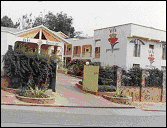
Iris Hotel (2002)
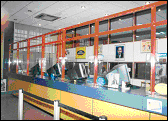
MTN Rwandacell (2002)
ANNUAL REPORT 2001 (ENGLISH)
I. INTRODUCTION
1.1 Production at national level
During the financial year 2001, the economic growth
rate was slightly higher than that of 2000. It amounted
to 6.7% as compared to 6.0% during 2000, which is
satisfactory even though it does not measure up
to the growth rate registered between 1996 and 1998
during the period of intensive reconstruction.
Table
1: Gross Domestic Product trends (in M RWF at current
prices, 1995)
Source : Ministry of Finance and Economic Planning,
Department of Statistics
The growth rate in this sector amounted to 41.8%
as compared to 29.3% for industries and 23.8% for
services. As regards GDP, agriculture continues
to play a major role, representing 46.0% of the
GDP as compared to 37.6% for services and 16.8%
for industries.
Between 1997 and 2001, production in the primary
sector increased faster than that of other sectors.
1.2 Bank loans
Outstanding loans in the Rwandan economy amounted
to 81,424.0 M RWF as at 31 December 2001 as compared
to 71,547 M RWF for 2000 and 66,420 M RWF for1999.
Short-term loans account for 62.6% of outstanding
loans against 37.4% in medium long-term loans.
In spite of the de-specialisation of banks since
1987, the Rwandan banking system continues to favour
short-term loans.
Table
2 : Outstanding loans by order of type of activity
and per term, in M RWF as at 31 December 2000 and
31 December 2001
The primary sector absorbed only 1.31% of outstanding
debts in spite of being the sector that contributes
the most to GDP.
2. ACTIVITIES OF THE BANK
2.1 Resolutions by the General Assembly and decisions
taken by the
Board of Directors
2.1.1 Resolutions by the General Assembly
TT
he Ordinary Shareholders' General Assembly took
place on 14 May 2001. During this meeting shareholders
accepted the reports of the Board of Directors and
that of the Auditors whereupon the latter were officially
released from their responsibilities during the
financial year 2000.
In addition, the General Assembly adopted the balance
sheet and the profit and loss accounts as at 31
December 2000 and decided to allocate the results
of the financial year amounting to 31,381,323 RWF
increased by a balance carried forward amounting
to 320,805,656 RWF in the following manner :
- Legal reserve (5%) : 1,569,066 RWF
- Dividends : 18,000,000 RWF
- Balance carried forward :332,617,913 RWF
TOTAL 342,186,979 RWF
The General Assembly of Shareholders appointed new
administrators: Mrs Marie MUKANTABANA, Mr Théogène
NGIRUMPATSE and Mr Charles MUNYAKARAMBI.
2.1.2 Decisions by the Board of Directors
During the financial year 2001, the Board of Directors
met six times in order to examine the Bank's performance
based on quarterly activity reports, and took strategic
decisions in order to help the Bank accomplish its
mission. The main decisions taken were the following
:
- Approval of project funding
- Approval of appointment of senior officials in
accordance with the policy of restructuring the
Bank
- Adoption of the Budget for 2001
- Approval of quarterly audit statements by KPMG
- Approval of the 2000 Annual Report.
2.2 Operational Activities
2.2.1 Funding of projects
During the financial year 2001, the BRD underwent
a significant increase in loan approvals. Loans
approved amounted to 3,873.5 M RWF in 2001 as compared
to 1,829.7 M RWF during 2000; an increase of 111.7
%.
Nevertheless, disbursements which amounted to 1,599.5
M RWF as at 31 December 2000 did not follow the
same pattern. On the contrary, they dropped to 32.4%
and stabilized at 1,08.7 M RWF as at 31 December
2001. These disbursements are 62% of approvals during
2001.
The intervals between approvals and disbursements
are mostly caused by delays and/or difficulties
fulfilling the conditions for disbursement. It is
important to also note that the majority of approvals
during 2001 were made during the 4th quarter.
Figure
1 : Approvals during the financial year 2001 by
order of sector
In the course of the financial year 2001, the Bank
received 174 requests for project funding amounting
to 10,983.1 M RWF. Of these, 56 were approved for
a total of 3,873.5 M RWF; 92 projects for a total
of 4,810.8 M RWF were rejected for various reasons
(insufficient profitability, inadequate contribution
by promoter, insufficient guarantees, very small
market, or even incomplete information).
As at 31 December 2001, 28 projects for a total
amount of 1,384.2 M FRW were being analysed or awaiting
examination by the Bank's Board of Directors.
In the framework of follow-up of projects, 76 project
visits were organised including 49 visits for follow
up and debt recovery and 27 routine visits normally
carried out before release of funds. |
2.2.1.1 Loan approvals
A total number of 56 projects were approved during
the financial year 2001 for a total amount of 3,873.5
M FRW. However, among these, one promoter withdrew
his application amounting to 300 M FRW. Thus the
operational projects were 55 for a total amount
of 3,573.5 M FRW.
Figure
2 : Advancement of approvals by order of sector
from 1997 to Primary sector
During the financial year 2001, 30 projects in the
primary sector were approved for a total amount
of 614.5 M RWF, i.e. 54.5% in number and 17.2% in
volume. In this sector, the Bank continues to support
agricultural projects by favouring their integration
into industrialization. Among the approved projects,
we can cite a particularly promising project for
intensive coffee cultivation. The livestock sector
continues to benefit from the Bank's support through
funding the importation of a third lot of improved
race dairy cows, so as to increase milk production
in the country, and thus reduce the need to import
milk.
In addition to this, the fish farming sector was
also supported, in particular the ISAMBAZA fish
farming project on Lake Kivu.
However, funding the agriculture and livestock sector
continues to come up against problems related to
lack of guarantees, low profitability, and other
structural problems.
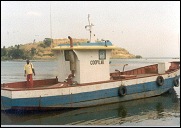
Secondary sector
Interventions approved in the secondary sector
amount to 12 projects for a total of 1,967.0 M
RWF, i.e. 55% of the total of effective approvals.
In this sector, projects approved during the year
range from the re-launching, rehabilitation, renewal
of production equipment and/or the extension of
existing factories manufacturing tomato sauce,
toilet paper, etc, to the creation of new projects.
Nevertheless, there are very few emerging industries
because of the current unfavourable economic climate.
Service industry
There are 13 approved interventions in this sector
adding up to a total of 992 M RWF, i.e. 23.6%
in number and 27.8% in volume. Most projects in
this sector are new, including the construction
of a new head office for one of the local banks
in Kigali.
Within this sector, the Bank continued to fund
schools infrastructure, as well as construction
and/or acquisition of furniture for medium-class
hotels in Kigali.
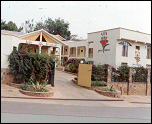
Table
3: Development of effective approvals by order
of sector from 1997 to 2001 (in M RWF)
2.2.1.2 Socio-economic impact of Bank interventions
Creation of Added Value
The expected Added Value of approved projects
amounts to 14,380.8 M RWF representing 61.8% of
projections ensuing from Bank projects.
The Added Value of the primary sector represents
38.5% of production as compared to 52.9% for the
secondary sector and 76.6% for the service industry.
Table
4 : Expected Added Value (in millions of Frw)
Job creation
As illustrated in Table 5 investments carried
out with the participation of the Bank during
the financial year 2001 will contribute to the
creation of 2,897 permanent jobs and will facilitate
the continuation of 870 jobs that already exist.
Among the new jobs to be created, 835 are in the
primary sector, 1,867 in the secondary sector,
and 195 in the service industry. It should be
noted that two of the projects within the secondary
sector involve plantations, thus safeguarding
the employment of over 3,000 people in the rural
areas.
Table
5 : Number of potential jobs by order of projects
approved in 2001
The average cost of 17.9 M RWF per job to be created
within the service industry is too high. This
is due to the fact that one project whose total
cost of 2,000 M RWF does not allow for the creation
of new permanent jobs, but facilitates the maintaining
of about 300 already existing jobs. Were this
project not to be considered, the average cost
per job within this sector would be 7.6 M RWF
and the overall average cost (for all sectors)
per job created which would normally be 6.8 M
RWF would be reduced to 5.8 M RWF.
2.2.1.3 Disbursements
The disbursements for the financial year 2001
amounted to 1,083.7 M RWF as compared to 1,599.5
M RWF for the previous financial year, i.e. a
decrease of 32%. This situation is caused mostly
by the delay in refinancing (payments from credit
lines currently available only became possible
during the 2nd semester of the year) and the delays
in fulfillment of imposed conditions by clients
who were unaware of the replacement of the Notary
Public (5 months' delay).
Table
6 : Development of disbursements in M RWF (1996
- 2001)*
2.2.2 Debt recovery
Debt recovery is subdivided into two categories,
by nature of debts:
- Normal debt recovery consisting of current debts,
debts to be monitored, bad debts and contentious
debts
- Forced debt recovery which concerns contentious
debts
2.2.2.1 Normal debt recovery
During the financial year 2001, the Bank collected
1,206.7 M RWF as compared to 1,083.3 M RWF collected
during the previous financial year, which implies
a positive increase of 11% . The average rate
of recovery amounted to 78%.
2.2.2.2 Forced debt recovery
The following situation illustrates the overall
picture of cases of forced debt recovery during
the financial year 2001 :
Out of 207 contentious loans totaling a risk of
3,449.3 M RWF, 139 loans totaling 2,754.4 M RWF
were taken to court. Among these cases a total
of 107 involving 1,152.3 million Frw received
court judgments whereas 32 cases involving up
to 1,602.1 M RWF are awaiting the court decision.
One case amounting to 2.6 M RWF is still with
the Bank's lawyer.
Regarding cases on which judgment was passed,
it is important to note that :
- Rulings in favour of sale by auction were made
in 13 cases totaling 999.8 M RWF
- Seizure of property was carried out in 18 cases,
totaling 1.3 M RWF
- Court summons were drawn up for 13 cases which
amount to a total of 327.1 M RWF
Forced debt recovery facilitated the stabilizing
of the debt portfolio at an amount of 642.7 M
RWF as compared to 3,074.9 M RWF of due payments
in 2001, leading to a forced debt recovery rate
of 21.1%.
This way, the number of contentious loans in the
portfolio was reduced. The total risk at the end
of the financial year 2001 amounted to 5,552.8
M RWF as compared to 6,282.6 M RWF at the end
of the previous year. The increase in the affected
portfolio amounts to 44.8 % of the total risk
as at 31 December 2001, as compared to 52.2% during
2000.
2.2.2.3 Overall debt recovery
Reimbursements during the financial year 2001
amounted to 1,862.4 M RWF as compared to 4,645.5
M RWF of due payments; an overall recovery rate
of 40,0%.
2.2.2.4 Outstanding payments
Outstanding payments evaluated as at 31 December
2001 amount to 2,821.3 M RWF as compared to 2,419.6
M RWF as at 31 December 2000. This implies a growth
of 17%. However, contentious debts which amounted
to 94% in 2000 decreased to 87% of the total outstanding
debts.
2.2.3 Administration
2.2.3.1 Organisational structure
The new organisational structure of the Bank that
was approved by the Board of Directors in the
month of November 2000 came into force on 1 April
2001. This new structure is centered on three
main activities of the Bank:
- Project funding
- Finance and treasury
- Corporate services
This way, the number of departments was reduced
from seven to three, the internal audit department
becoming an independent unit directly attached
to the Office of the Managing Director.
This restructuring involved the elimination of
certain posts to facilitate the recruitment of
skilled personnel. A new salary scale was adopted
and applied starting from 1 April 2001. At the
same time, Bank procedures, job descriptions and
performance appraisals were reviewed and are being
finalised.
2.2.3.2 Staff training
Given that the existing personnel had neither
the training nor the skills required, Analysts
and Directors underwent training in " Risk
Management ". Heads of Units and Directors
also underwent a course on " Management Techniques
". Apart from these two training sessions,
the Bank also sponsored the following courses
:
- An academic course undertaken by two staff members
at the Université Libre de Kigali (ULK)
- A correspondence course in Human Resources Management,
undertaken by a staff member, at the University
of South Africa (UNISA)
- An English course at the Kigali Institute of
Science and Technology (KIST) taken by two staff
members.
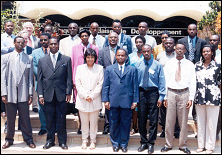
On another note, the entire staff of the Bank
underwent a basic course introducing them to computers
and use of software. Four secretaries also underwent
a crash course for Executive Secretaries.
2.2.3.3 Human resources
The number of employees decreased from 48 on 31
December 2000 to 44 on 31 December 2001, a result
of 14 departures and 10 appointments.
- One senior official was assigned other duties
by the government for other duties, eight employees
had their contracts terminated due to restructuring
within the Bank, 3 employees resigned and 2 senior
officials passed away.
- Nine staff members were recruited in conformity
with the new policy of restructuring including
two senior officials. One support staff was also
recruited.
2.2.3.4 Computerisation of the Bank
The main aspects of this computerisation are the
following :
- Installation of a LAN system
- An intranet system for the Bank
- Access to the internet for all staff members
- Computerisation by Delta-Bank.
- Installation of a LAN system for the Bank
Three phases were carried out, namely : extension
of computer cables to extend access to the network
from 22 to 46 outlets (RJ 45) ; installation of
a Compaq 530 ML server, and the deployment of
work posts.
- An intranet system for the Bank
Actions carried out were the acquisition and installation
of the antenna and "router" of a wireless
internet provided by KIST, and the configuration
of the local internet server as well as that of
the " brd.com.rw " domain.
The establishment of an intranet system within
the bank coupled with the creation of 29 'accounts'
for electronic messages is a significant step
forward in the process of computerising the Bank.
Already the intranet has improved internal communication
by fostering information exchange at very little
cost. A website attached to the above-mentioned
domain will soon be installed.
- Computerisation by Delta-Bank
This project took up an excessive amount of time
during the year, including time for the recovery
of existing loan applications, start-up and parallel
run but without any result considering the high
expectations of an integrated computerisation
of Bank operations. The Bank is considering alternatives
for a permanent resolution of this problem during
the financial year 2002.
2.2.4 Relationship with other financial institutions
2.2.4.1 Local financial institutions
The Bank participates in the financial market
by placing excess cash in commercial banks when
needed, or by borrowing cash on short-term basis.
During the financial year 2001, BRD made investments
totaling to 1,126.7 M RWF as compared to 315.0
M RWF as at 31 December 2000, which implies an
increase of 258%. This large increase of deposits
is a result of disbursements on external credit
lines and loan repayments which generate resources
that surpass their utilization.
2.2.4.2 International financial institutions
In the year 2001, a total of 1,104.8 M RWF was
drawn on the BEI III et FAD III credit lines for
the amounts of 753.3 M RWF and 351.5 M RWF respectively.
Loan repayments during this period amounted to
631.5 M RWF including 272.0 M RWF in principal,
40.5 M RWF in interest and 318.9 M RWF as difference
in foreign exchange. The balance in loans as at
31 December 2001 amounted to 3,934.0 M RWF as
compared to 3,083.2 M RWF of the previous year.
Mobilisation of funds from external sources increased
by 28%.
The Bank is maintaining contacts with other donors
such as BADEA, IFAD, KFW, and IDA and new lines
of credit are likely to be obtained during 2002.
Furthermore, negotiations with DBSA for capacity
building within the Bank were intensified during
the financial year 2001 and should culminate in
an operational plan for 2002.
2.2.4.3 BRD/SME Guarantee Fund
The Bank is managing a Guarantee Fund in favour
of SME. During the financial year 2001, guarantees
issued by this fund amounted to 303.3 M RWF as
compared to 352.6 M RWF as at
31 December 2000. Annual audits are now carried
out on this fund.
Table 7 illustrates the Fund capacity as at 31
December 2001 for new guarantees, which amounts
to 490.4 M RWF as compared to 350.6 M RWF as at
31 December of the previous year.
Table
7 : BRD/SME Guarantee Fund Capacity (in RWF)
3. FINANCIAL SITUATION OF THE BANK
3.1. Loan portfolio
3.1.1. Outstanding loans
Outstanding loans as at 31st December 2001 amounted
to 4,578.2 M RWF as compared to 5,170.5 M RWF
as at 31st December 2000, which implies a decrease
of 11.5%. The following table illustrates the
development of outstanding loans by order of type
of activities during the last six years.
Table
8 : Development of outstanding loans by order
of type of activity in M RWF (1996 - 2001)²
An overview by sector shows that the Bank's activities
mainly involve the secondary sector except for
the financial year 2001, during which two important
outstanding loans were compromised (UTEXRWA and
SORWACI) and others who had not yet fulfilled
the conditions for the release of funds by the
end of the financial year, namely SORWATOM and
Kabuye Sugar Works.
3.1.2 Outstanding loans by order of type of
risk
Bad, litigious and contentious debts were reduced.
These debts amounted to 2,860.5 M RWF at the end
of 2001 as compared to 3,250.9 M RWF as at 31
December 2000, a 12% decrease.
The rate of contentious loans which had amounted
to 41% of outstanding loans in 2000 was reduced
to 34% in 2001.
Table
9 : Development of loan portfolio per risk classification
in millions of Frw (1998 - 2001)
3.1.3 Investments portfolio
The Bank did not undertake any new investment
during the financial year 2001. The dividends
collected during 2001 were earned in existing
investments and amount to 89.7 M RWF as compared
to 2.3 M RWF during 2000 and 122.1 M RWF during
1999.
Figure
3 : Development of the portfolio structure from
1998 to 2001
3.2 Financial situation of the Bank
3.1.1 Report of the auditors to the shareholders
We have audited the financial statements set out
on pages 24 to 34 which have been prepared on
the basis of the accounting policies set out in
Note 1. We have obtained all the information and
explanations which to the best of our knowledge
and belief were necessary for the purposes of
our audit and to provide a reasonable basis for
our opinion. The financial statements of the bank
are in agreement with the books of account.
Respective responsibilities of directors and independent
auditors
The directors are responsible for the preparation
of financial statements which give a true and
fair view of the state of affairs of the bank.
Our responsibility is to express an independent
opinion on the financial statements based on our
audit and to report our opinion to you.
Basis of opinion
We conducted our audit in accordance with the
International Standards on Auditing. Those Standards
require that we plan and perform the audit to
obtain reasonable assurance about whether the
financial statements are free of material misstatement.
An audit includes examining, on a test basis,
evidence supporting the amounts and disclosures
in the financial statements. An audit also includes
assessing the accounting principles used and significant
estimates made by management, as well as evaluating
the overall financial statement presentation.
We believe that our audit provides a reasonable
basis for our opinion.
Emphasis of the matter
Without qualifying our opinion, we draw attention
to note 7 to the financial statements, which gives
disclosures on the tax status of the bank and
amounts due from Rwanda Revenue Authority.
Opinion
In our opinion, proper books of account have been
kept and the financial statements give a true
and fair view of the state of financial affairs
of the bank as at 31 December 2001 and of its
operating results and cash flows for the year
then ended in accordance with the International
Accounting Standards.
KPMG Peat Marwick
CHARTERED ACCOUNTANTS
PO Box 5292 Kigali
3.1.2
Balance sheet at 31 December 2001
The balance sheet is to be read in conjunction
with the notes to and forming part of the financial
statements set out on pages 24 to 34.
3.2.3 Profit and loss account for the year ended
31 December 2001
3.2.4
Cash flow statement for the year ended 31 December
2001
3.2.5 Notes to the financial statements for
the year ended 31 December 2001
1. SIGNIFICANT ACCOUNTING POLICIES
The principal accounting policies adopted in the
preparation of these financial statements are
set out below:
Basis of preparation
The financial statements set out on pages 4 to
19 have been prepared under the historic cost
basis of accounting modified by the inclusion
of certain property and equipment on revalued
basis. The financial statements comply with International
Accounting Standards (IAS).
Income recognition
Income is recognised in the period in which it
is earned except for dividends which are recognised
when received. When an account becomes non-performing,
interest is suspended until it is realised on
a cash basis.
Provision for losses on loans and advances
Specific provisions for doubtful debts are held
in respect of loans. Provisions, based on periodic
appraisals of the advances portfolio, made in
relation to identified risk on loans and advances,
and in compliance with National Bank of Rwanda
(BNR) reflect an estimate of loss expected and
are charged to the profit and loss account. In
addition, a statutory general provision is made
in accordance with the National Bank of Rwanda
guidelines.Loans and advances considered uncollectable
are written off after all the necessary legal
procedures to recover the amounts are exhausted.
The rates of provisions applied are as follows.
Doubtful advances 20%
Advances under legal action 50%
Losses 100%
Translation of foreign currencies
Loans received from foreign financial institutions
are translated to Rwandese francs at the rate
of exchange ruling at the date the loans are received.
The differences in exchange arising on repayment
of loans are borne by the Rwandese Government.Other
transactions during the year are converted into
Rwandese Francs at the rate ruling at the transactions
date. Assets and liabilities, which are expressed
in foreign currencies in exception of loans from
foreign financial institutions, are translated
into Rwandese Francs at the exchange rates ruling
at balance sheet date. The resulting differences
from conversion are dealt with in the profit and
loss account in the year they arise.
Property and equipment
Property and equipment are stated at their historic
cost or re-valued amount less depreciation. Depreciation
is calculated to write off the cost or the revalued
amount of property and equipment on a straight-line
basis over their estimated useful lives using
the following rates:
Office buildings 2.5%
Residential buildings 6.25%
Motor vehicles 20%
Office equipment and furniture 20%
Others 20%
Capital work in progress Nil
Excess depreciation is the difference between
the depreciation charge for the year based on
the revalued amount and the original cost of the
related property and equipment. On an annual basis
the amount relating to the excess depreciation
is transferred from revaluation reserves to retained
earnings to recognise the use of the property
and equipment.
Loans and advances
Loans are generally shown at the principal amount
adjusted for any provision for loan losses. The
provision for loan losses is increased by charges
to income and decreased by charge-offs (net recoveries).
Investments
In the absence of a formal market, the directors
use the following basis to determine the value
of shares. Investment are stated at cost and adjusted
for revaluation or diminution in value. Investments
are revalued upwards on receipt of bonus shares
based on the nominal value of the shares received.
Full provision for diminution in value of shares
is made when an investment is considered unlikely
to ever return dividends. Dividends are recognised
in the profit and loss on receipt.Investments
held which represent between 20 - 50% of a company's
share capital are treated as investments rather
than associates. Investments which are in excess
of 50% of a company's share capital are treated
as investments where in the opinion of the directors,
their operations are dissimilar or the bank does
not have influence over their operations.
Cash and cash equivalents
Cash and cash equivalents include cash balances
on hand, balances deposited with the National
Bank of Rwanda, net balances from banking institutions
and investments with maturities of three months
or less when acquired.
Employee benefits
The bank's employees are eligible to a retirement
benefits under a non-contributory defined contribution
scheme. Contributions to the defined contribution
scheme are charged to the profit and loss as incurred.
Comparatives
Where necessary, the comparatives have been restated
2 INTEREST INCOME
Table
3 INTEREST EXPENSE
Loans and grants from donors 125,990,586
129,461,539
4 NON INTEREST INCOME
Table
5 NON INTEREST EXPENSES
Table
The following item is included within salaries
and employee benefits
Table
The average number of employees engaged during
the year was:
Table
6 PROFIT BEFORE TAXATION
Table
7 INCOME TAX EXPENSE
Table
The bank was set up on 5 August 1967 by a law
that provided that it was exempt from taxation.
Subsequently, in 1997, the Income tax Act was
amended with a provision that all entities, except
those specifically exempted under the Act are
taxable.
Based on the amendment to the Income tax Act in
1999, the Rwanda Revenue Authority (RRA) made
an assessment of the tax payable by the bank and
attached the bank's accounts with the National
Bank of Rwanda and other banks. As a result, 518,716,667
RWF of the banks funds was withheld in the year
2000. The bank contested the above action by RRA
and the matter is currently before the Court of
Appeal.
In view of the above, and to ensure uninterrupted
operations of the bank, the directors have paid
157,979,801 RWF to RRA being equivalent taxes
payable to forestall efforts to attach the assets
of the bank.
The directors have taken a legal opinion, which
confirms that the bank is still tax exempt and
the amounts paid to RRA are recoverable. As at
the year-end such payments amounted to 676,696,468
RWF (2000: 632,506,598 RWF). The directors have
relied on this advice and the financial statements
have been prepared accordingly.
8 BASIC EARNINGS PER SHARE
The calculation of basic earnings per share is
based on:
Table
There were no potentially dilutive shares outstanding
at 31 December 2001 and 2000.
9 DIVIDENDS PER SHARE
Dividends per share is calculated on dividends
of Rwf (2000 - Rwf 18,000,000) and on the number
of shares in issue at the respective balance sheet
dates of 1,484,397 (2000-1,484,397).
10 CASH AND BANK BALANCES
Table
11 INVESTMENTS IN GOVERNMENT SECURITIES
Table
The weighted average interest rate on Government
securities at 31 December 2001 was 7.5% (2000
- 7.5%).
12 PLACEMENTS WITH OTHER BANKS
Table
The weighted average effective interest rate on
placements with other banks at 31 December 2001
was 10.5% (2000 - 9%).
13 LOANS TO CUSTOMERS
Table
Provision for bad and doubtful debts and interest
in suspense
Table
The weighted average interest rate on loans and
advances to customers at 31 December 2001 was
15% (2000 - 15%).
14 INVESTMENTS
Table
15 CURRENT ASSETS
Table
|

